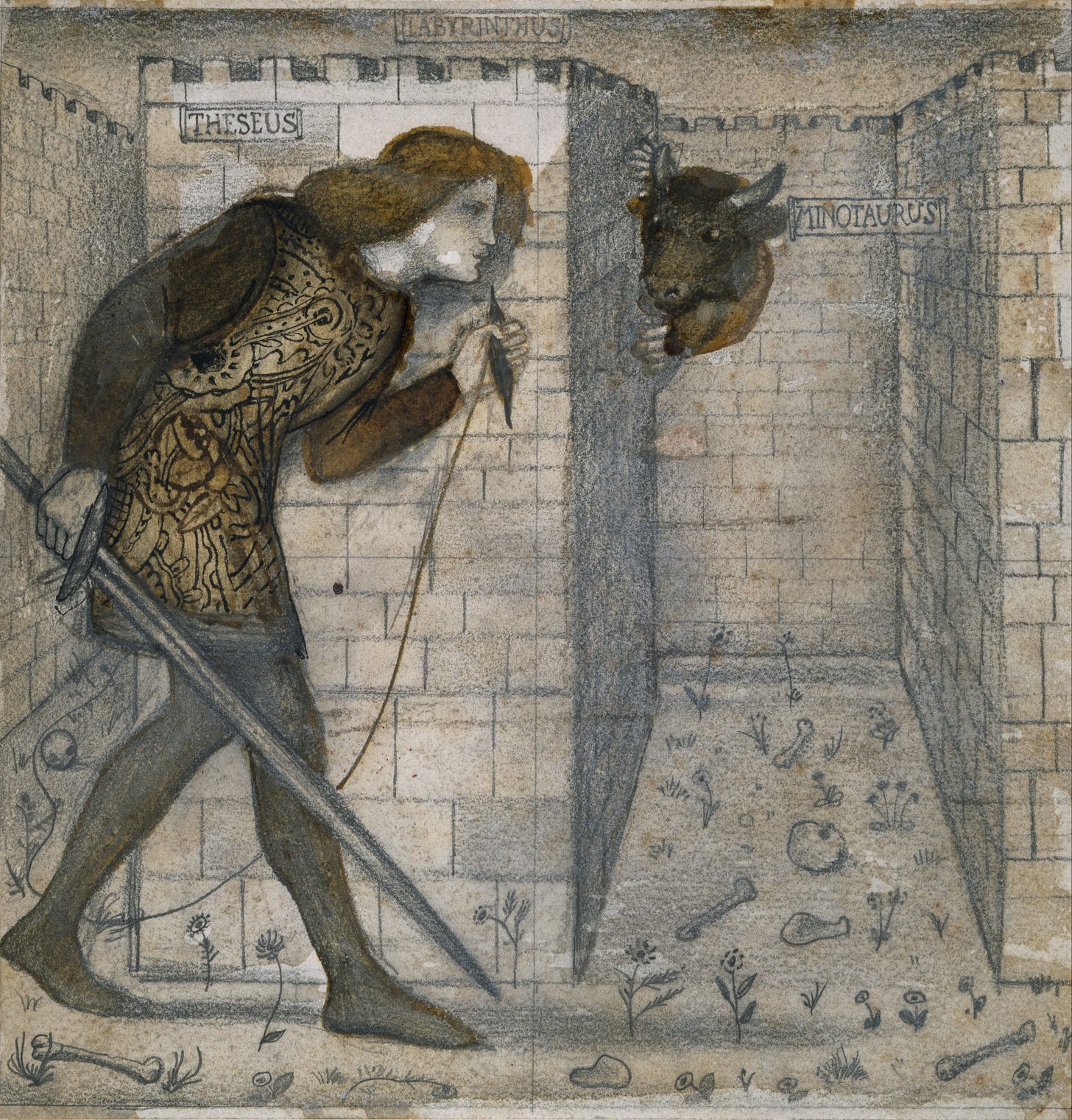Embrace myth: A route out of the nihilistic labyrinth
Dismissing myth is a tale of folly, not wisdom.
My first foray into myth was Classics GCSE, studying Ovid’s Metamorphoses. I enjoyed it, yet my overriding feelings were perplexion, and empathy for Juno—putting up with her philandering husband, Jupiter.
I realise the folly of viewing myths so literally. What can you expect of a teenager, however? To understand the ‘hidden’ prescriptive element? Yeah, right.
Myths can help frame situations and challenges. In The Hero with a Thousand Faces, Joseph Campbell posits that a dearth of myth and rite—which “supply the symbols that carry the human spirit forward”—may explain high rates of neuroticism; people suffer without these “effective spiritual aids,” as he puts it.
This decline has hastened since the book was published in 1949. Without these spiritual aids many feel rudderless, drifting in the great cosmic soup—no wonder nihilism, unfortunately, is on the rise.
’s article, The Age of Abandonment, elucidates the peril of ignoring Chesterton’s Fence and following Luciferian intellect:“Throughout history our ancestors built customs and institutions to bind us together and then, one by one, we kicked them down. We killed God. . . we debunked every last myth and story. And we kept going and going, until we got here. . . Welcome to the age of abandonment.”
We humans are so story-based. Surely it’s been the most effective way to transmit wisdom through generations.
The most essential messages stand the test of time. The wheat gets separated from the chaff until the wisdom is distilled as concisely as possible: “Far from being untrue, then, mythologies become both more true and repositories of deeper and richer truth over time. They serve as a sort of highly compressed data structure,” says
in his truly deep-dive article, The Reenchantment of the Word.We have a limit to how much we can consciously process at once. Myths appear to be able to work within this ‘limit’—deep wisdom is packaged in a sort of ZIP file that the ‘human computer’ can read and extract the ‘hidden’ meaning from. Jordan Peterson expands on this point in We Who Wrestle With God:
“The world has to be filtered through the mechanism of story to become comprehensible or even apprehensible; because the world is simply too complicated to attend to and to navigate within the absence of aim and character (which are defining features of story itself).”
The content of prevailing stories/myths is no trivial thing. “Praising heroes and demonising villains. . . shape expectations of what is widely revered and respected,” says
in her article, Censored: 20th Century Struggles Over Cinema.A convincing article by
, Evil is not a Mental Illness, highlights the danger of rebranding truly evil monsters as misunderstood characters to be pitied. Pretending evil does not exist, and failing to use the power of storytelling to provide a prescriptive antidote, only benefits the truly malevolent.’s article, Dangerous Women, follows a similar argument to Megha's, with a greater focus on how the alteration of female-led myths, particularly the Princess’ Journey, no longer hold sufficient prescriptive advice for women to counteract the variety of ways malevolence can pose a threat. Echoing the rebranding Megha discusses, Pitor illustrates how the archetypal Evil Woman is often given an origin story and becomes a tragic antihero.Who are the monsters if the originally evil ones are no longer clear-cut monsters? There seems to be an undercurrent or suggestion that you, yes you, are the monster for daring to judge this poor victim (who due to their origin story seems to be given carte blanche).
As we come to a close, I quote John’s aforementioned article, and below it, an excerpt from The Hero with a Thousand Faces:
“To reenchant the world is almost by definition to permeate it once again with the connective tissue of mythos. . . To reenchant the world is simple in concept, extraordinarily difficult in execution: we must tell a better story.”
“If we could dredge up something forgotten not only by ourselves but by our whole generation or our entire civilization, we should become indeed the boon-bringer, the culture hero of the day—a personage of not only local but world historical moment.”
Are you content with the current story? Do you agree with who are deemed heroes and villains? Or do we need a fresh perspective, a better story?
Don’t be tempted by the siren call of nihilism. Help us form a better story. If the story is compelling enough, others will willingly get on board. Pick up an oar and help guide us through the cosmic soup towards a new North Star.
“The Hero with a Thousand Faces remains the best book about storytelling ever,” according to Blake Snyder, one of Hollywood’s most successful spec screenwriters, and author of the excellent book, Save the Cat! If this article has piqued your interest, I highly recommend you check out the books and articles mentioned in this piece.






We need a travelling bard to sing tales round about the kingdoms and nations of our folk. He shall not just sing, but he shall make you feel as if you were there
ਖੰਡਾਪ੍ਰਿਥਮੈਸਾਜਕੈਜਿਨਸਭਸੈਸਾਰੁਉਪਾਇਆ॥
kha(n)ddaa pirathamai saaj kai jin sabh saisaar upaiaa ||
At first the Lord created the double-edged sword and then He created the whole world.
ਅਕਾਲ